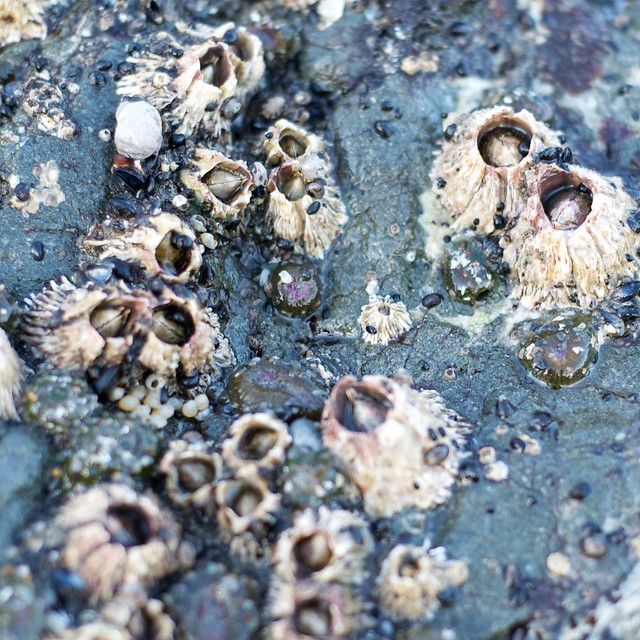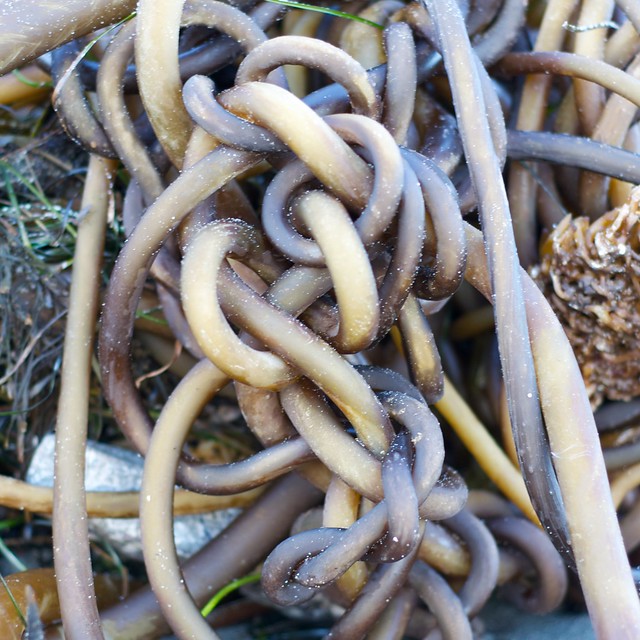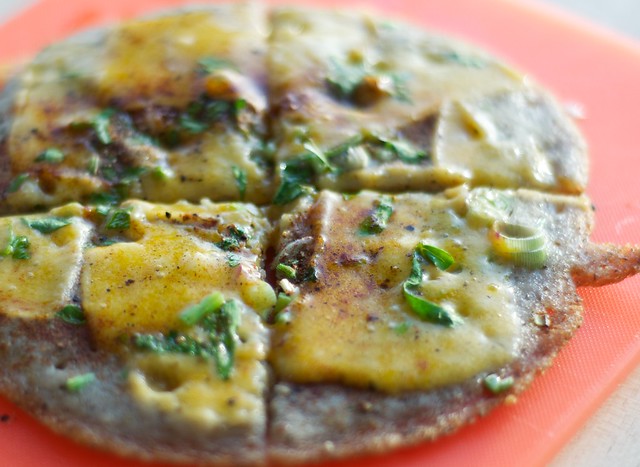
American uttapam (salt, pepper, cumin seeds, cilantro, diced onions and bell peppers, cheese)

Simple uttapam (salt, pepper, cumin seeds, cilantro, onion, paprika, sesame seeds)
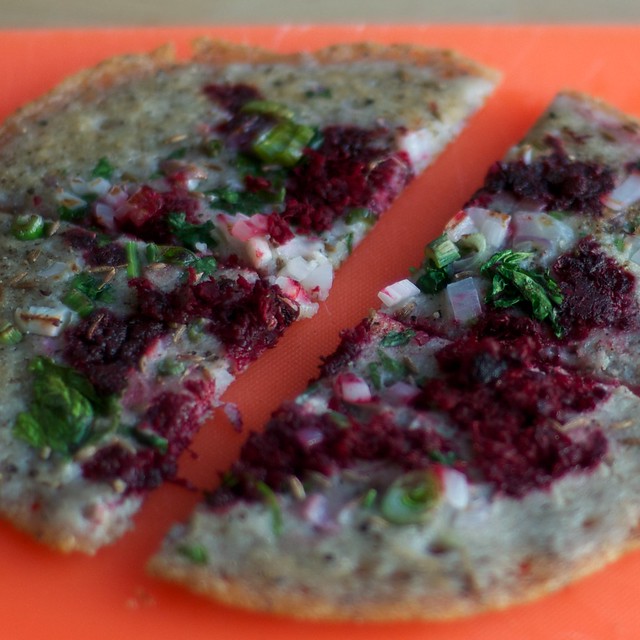
More advanced uttapam (salt, pepper, cumin seeds, grated beets, chopped fennel)
With this recipe I must offer a disclaimer. Firstly, I am not South Indian.
Secondly, this recipe is not a hand me down from my mother, or her mother, or any long lost family relative from generations of genius cooks. This recipe is solely born out of my singular obsession with certain South Indian foods which happen to contain soaked rice and udad dhal.
Thirdly, I am an ABCD* that speaks fluent, funny sounding Gujarati. If you put a vegetarian south Indian dish in front of me, it will be devoured. Murukku have no chance of surviving. Your extra rasam will find it's way into my stomach. Any dosa batter you had on hand, will be carried out of your home. Idlis? Gone.
*An ABCD is an American-born confused desi. Non-resident Indians (NRIs) that settled in the US, call first generation Indians ABCDs because of our broken sounding language skills and lack of proper desi identity. And the fact that I have lumped all the South Indian states into a single culinary tradition.
My obsession has proven to be useful. For a few years, the only Indian dish I would prepare would be dosa and sambar. Sometimes I'd venture out and make idli's, or chole, but this dish was the only dish I'd prepare regularly. It's unfortunate, that I overlooked uttapam for so long because it contains the same traits that I love about dosa: the planning, the soaking, the grinding, the inevitable wait for the bubbly to occur. If dosa is a lean, crispy, fattening, thin rice crepe, then uttapam is the stocky, well-rounded, rice griddle pancake. But uttapam is so much better. You serve it like an upside down pancake, and while it cooks, you can add toppings to it, so it's kind of like a griddle-cake pizza.
Uttapam is made out of a base of white rice and udad dhal or split black gram. These two ingredients are added to a bowl, covered with water, and allowed to soak overnight. Once done soaking, they are blended together, allowed to rest in a warm spot overnight, and then given a few last minute additions before being the world's answer to the best damn savory pancakes.
So how can you make it? You need four main ingredients: long-grain white rice and brown rice, yellow split peas, and udad dhal. I know - this list seems long, however these ingredients are shelf-stable and don't require much storage room. And once you start preparing the batter weekly, you'll have all the ingredients in your larder. Of these essential ingredients, udad is key. It's sold as urad, udad or black Bengal gram, and is often sold in one of three ways: 1) whole and peeled so it looks white, 2) it is sold split with the black skins on, or 3) it is sold split with no skins. Any variety of these will work. I have tried them all. While not common in grocery stores or co-ops, urad dhal can be purchased online, or a south Asian grocery store.
Finally, I want to note here that I've experimented with different types of lentils so that you won't have to. I've experimented with different ratios of lentils to rice. Of the lentils, I've tried: yellow-split peas, red lentils, green split peas, regular grocery store lentils, and mung beans. I find that udad dhal works the best, and I like the body the yellow-split peas provides. Since I wanted to try healthier types of whole grain rice, I've also tried different ratios of: white and brown basmati rice and white jasmine rice, grocery store regular brown rice, grocery store regular long grain rice, parboiled long-grain rice, forbidden black rice, and red wehani rice. Of these rices, all of the long-grain varieties worked, but the forbidden black rice and the red rices were too starchy and caused the uttapam to stick when cooked. So far, I found half white rice and half brown rice to be a good cooked consistency.
Ready to get started?
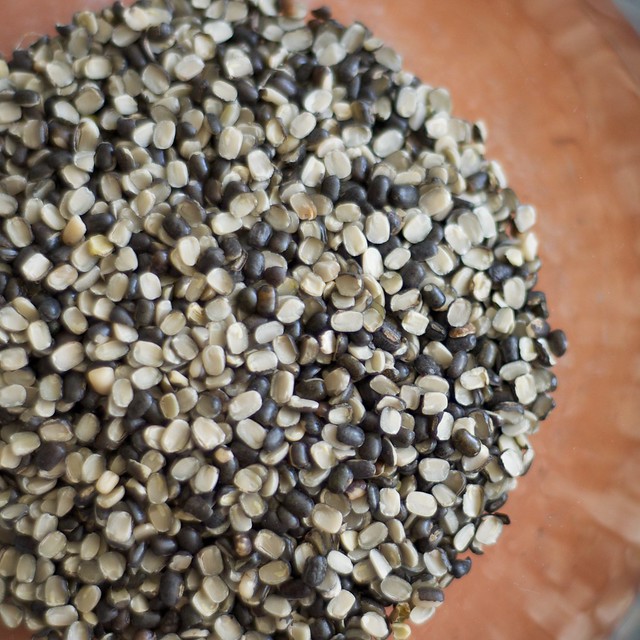
For my uttapam, I add 1/2 cup (100 g) udad dhal to a large bowl.
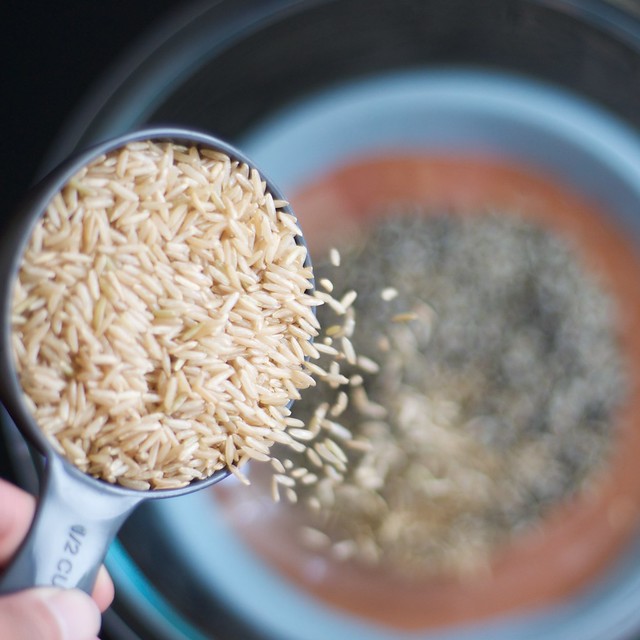
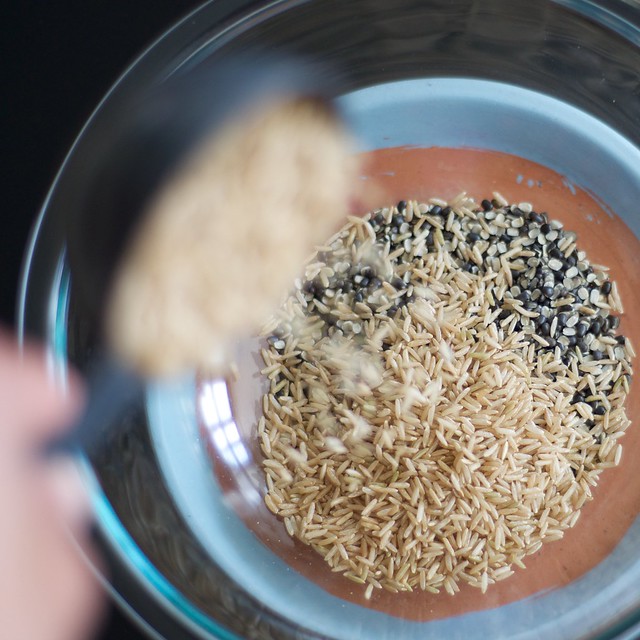
Then I add 1/2 cup (105 g) of long-grain organic brown rice (these pictures were fun to take).
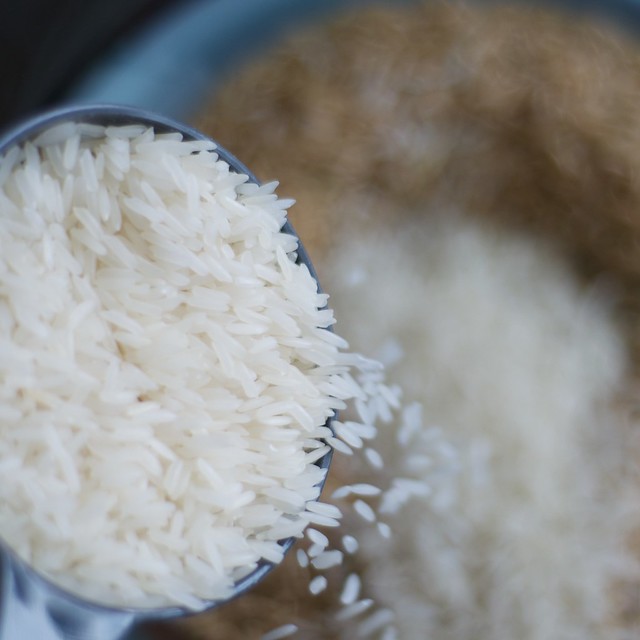
Next, add 1/2 cup (120 g) of long-grain white rice.
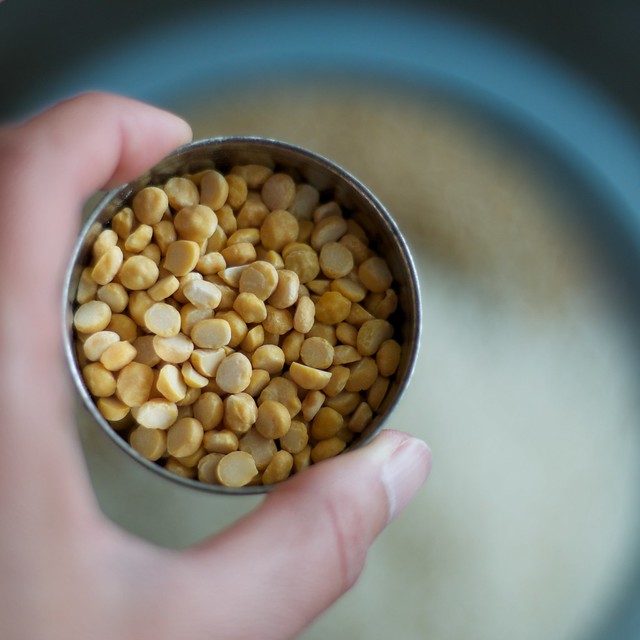
Next, add 2 tbsp (25 g) of yellow split peas (or channa dhal) to the bowl.
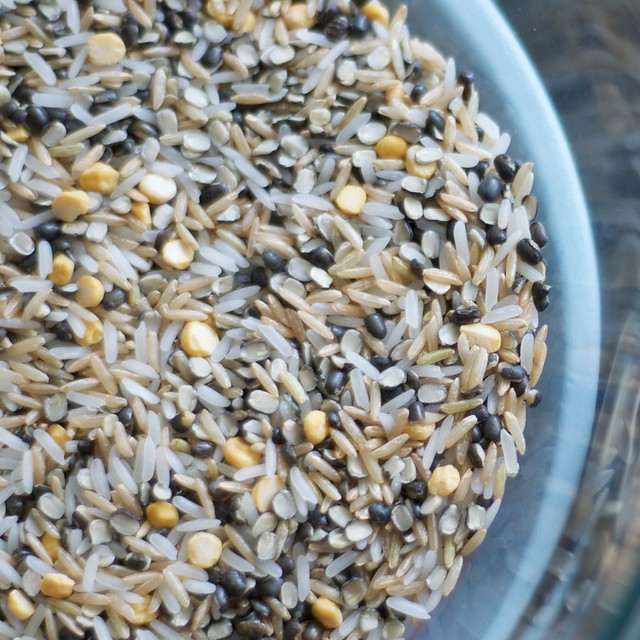
Once these 4 ingredients have been added, stir the contents of the bowl. The next step is adding water and then letting the lentils and rice soak overnight.
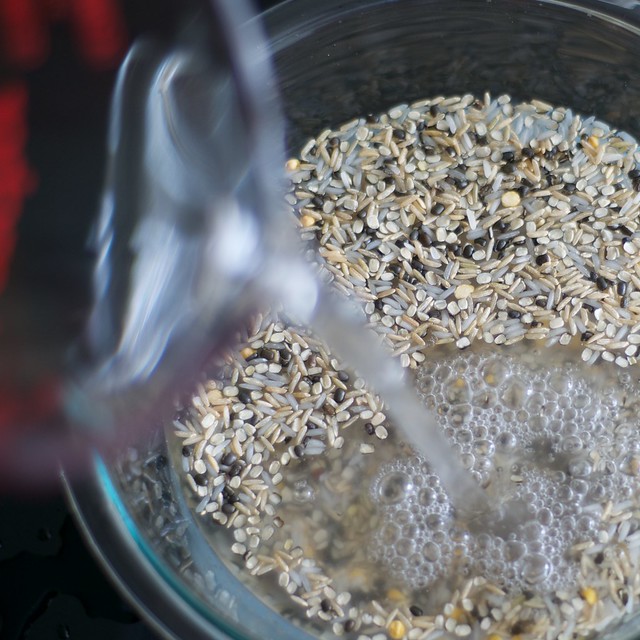
Pour in about 2 cups of cold water and let it soak overnight. I like to place a plate on top and then place the bowl in the oven.
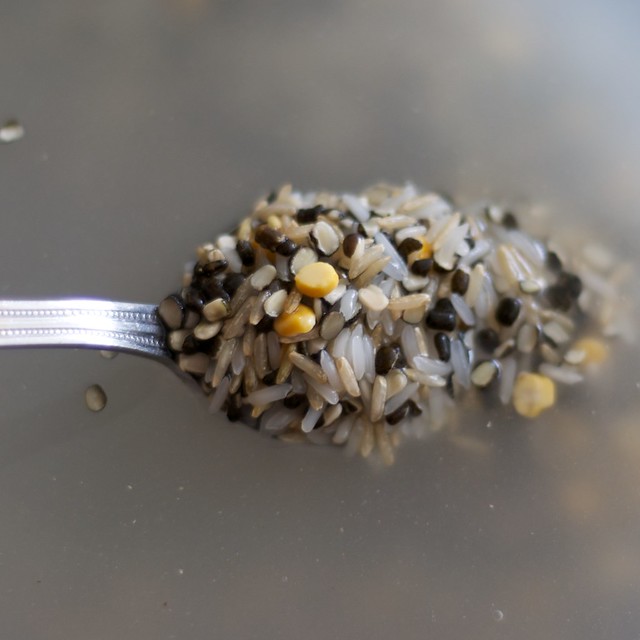
The soaked lentils and rice should like this after pouring water into the bowl.
Then, the next day:

Drain off the water from the soaked lentils and rice, and add them to the food processor. Make sure the mixing blades are in the food processor. The udad dhal may look green. That's ok.
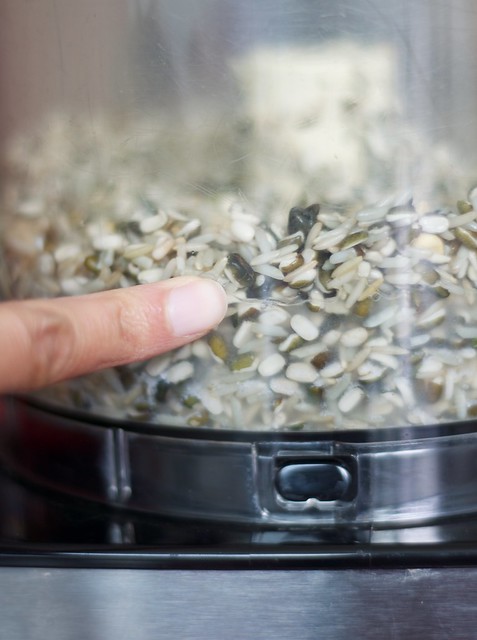
Pour in about 1/2 cup to 1 cup of water. This is about how much water is needed. About 2 tablespoons of plain yogurt may be added at this step.
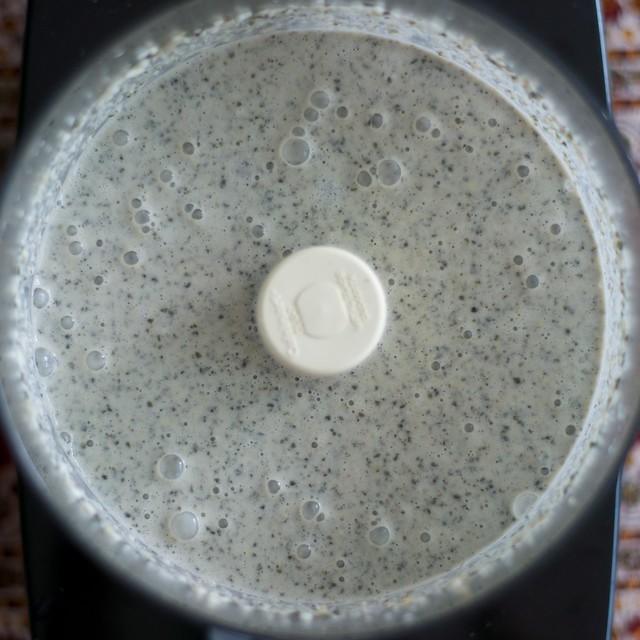
Blend for 1 minute. Scraping down the sides with a rubber spatula. Process for 15 second to 30 second intervals until the texture is uniform.
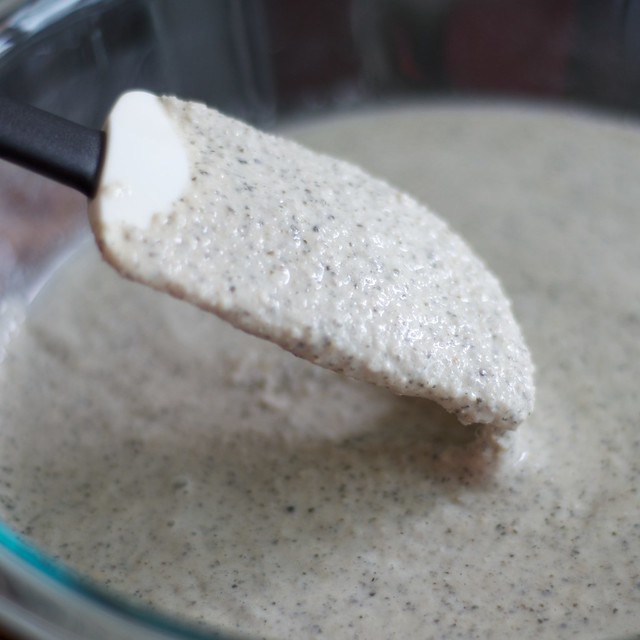
The uttapam batter is ready to rest. Now at this step, the uttapam batter should be covered with a plate or plastic wrap, and placed in a warm area to ripen. This can take a few hours to overnight, depending on how warm your kitchen remains. I like to place the bowl in the oven.
The recipe follows below. While this might not be an authentic recipe, it's easily replicable in any kitchen with a blender or food processor.
Neeli's inauthentic tasty Uttapam
Yield: 4 servings, such as 2 to 3, 6" uttapam per person. This recipe is best thought of as prepared in multi-day steps. Day 1: soak ingredients. Day 2: blend ingredients and allow them to rest. Day 3: Eat! Repeat! I recommend serving for lunch or breakfast.
Special tools: a large mixing bowl, a food processor, patience and curiosity.
Day 1: Foundation for batter (these ingredients will be soaked together)
1/2 cup (100 g) udad dhal (please note that split black gram, whole black gram, peeled split black gram, or unpeeled split black gram will all work fine)
1/2 (120 g) long grain white rice (basmati, jasmine, or regular grocery store long-grain rice, I prefer organic)
1/2 cup (105 g) long grain brown rice (basmati, jasmine, or regular grocery store brown long-grain rice is fine, I prefer organic)
2 tbsp (25 g) yellow split peas or channa dhal, mung beans can be OK too here, although sometimes they sprout if left to soak for too long.
2-4 cups water
Day 2: Blending time
the drained rice and lentils
2 to 3 cups of water, may reserve the soaking water, or can use fresh water.
2 T to 1/4 cup yogurt (can be omitted)
Directions for Day 1 and Day 2:
Step 1: I rinse the rice and the lentils. Purists will not rinse, but these are organic products from the earth, and I have made three batches where a stone, yes a stone, has been ground into the batter. Trust me, NO ONE wants to bite down on a stone, and tiny stones are not good for your blender or food processor blades. Rinse the lentils and rice well. After rinsing, add them to a large mixing bowl and cover with water. Cover the bowl and let the lentils and rice soak for 1 day, or overnight. For example, you may soak the lentils and rice overnight. Then, the following day the rice and lentils can be blended in the morning. Alternatively, you may soak these together before going to work in the morning, and when you get home you can blend the batter.
Step 2: Drain the water from the soaked lentils and rice. Inspect the rice and lentils carefully for any loose stones or rocks. Set aside about 2-3 cups of water. We will not use all the water.
Step 3: Place the drained and soaked rice and lentils into the work bowl of a food processor, or blender. Pour in 1/2 cup to 1 cup of water into the work bowl. Process or blend together for about 1 minute. After 30 seconds, stop the blender or food processor and use a rubber spatula to scrape down the sides. Only add water if it's too dry. We want a batter with the consistency of pancake batter. Continue processing until all the lentils and rice are uniformly blended. We will not use all the soaked water.
Step 4: Now, a controversial step. I add about 1-2 tbsp of plain yogurt to my batter to kickstart the fermentation, and add a bit of sourness to my batter.
Kataash perhaps (a slight tang or pleasant sourness). I add it towards the end of the blending time. For example, once my batter has reached the proper consistency, I pulse in some yogurt until well blended.
Step 5: Turn out the batter to a bowl and cover with plastic wrap or a towel. The batter can be allowed to rest on the counter or in the oven. After a day, place it in the fridge until ready to make. I find it helpful to place reminders on my cell phone to avoid forgetting about the batter.
Day 3: Cooking time
Yield: 4 servings, such as 2 to 3, 6" uttapam per person.
1 recipe of uttapam batter
1/4 cup semolina or
sooji (common ingredient in couscous, and processed into Cream of Wheat)
1/2 tsp salt to taste
1/8 tsp baking soda
Oil (peanut or olive is fine)
Toppings:
flaked sea salt and fresh black pepper
fresh cilantro, chopped
sliced jalapeno rings, remove seeds
cumin seeds, whole
paprika, ground
shredded carrots or beets
diced onions and bell peppers
cheese, cheddar or mont jack
Other nice toppings: chopped fennel, diced tomatoes, diced avocado
Cooking Directions:
Step 1: To the batter, add about 1/4 cup of semolina (
sooji), salt to taste, and a thick pinch of baking soda. Stir to combine. The semolina is a non-stick trick. If omitted, the first few uttapam will stick to the pan, but will eventually stop once enough oil is used. If omitting the semolina, be generous with the oil.
Step 2: Meanwhile, heat up a non-stick griddle, or a cast-iron over medium heat. Add some oil and once hot, pour in about 1/4 or 1/3 cup batter. I like to use a measuring cup or ladle. The batter will spread out, and you can help it. Drizzle a little oil around the edges. Cook for 1-2 minutes over medium heat. Now, to the toppings.
Step 3: The uttapam can be topped with anything. I like these variations:
Simple: salt, pepper, cumin seeds, cilantro, onion, paprika.
Advanced option 1: salt, pepper, cumin seeds, grated beets, chopped fennel.
Advanced option 2: salt, pepper, cumin seeds, cilantro, paprika, diced fennel
American: salt, pepper, cumin seeds, cilantro, diced onions and bell peppers, cheese
4. Add the toppings of your choice, cook about 3-4 minutes longer, and if desired flip over to cook bottom. The flipping over step may be omitted. Serve immediately toppings side up, with some fresh tomatoes, cilantro chutney, and yogurt.






